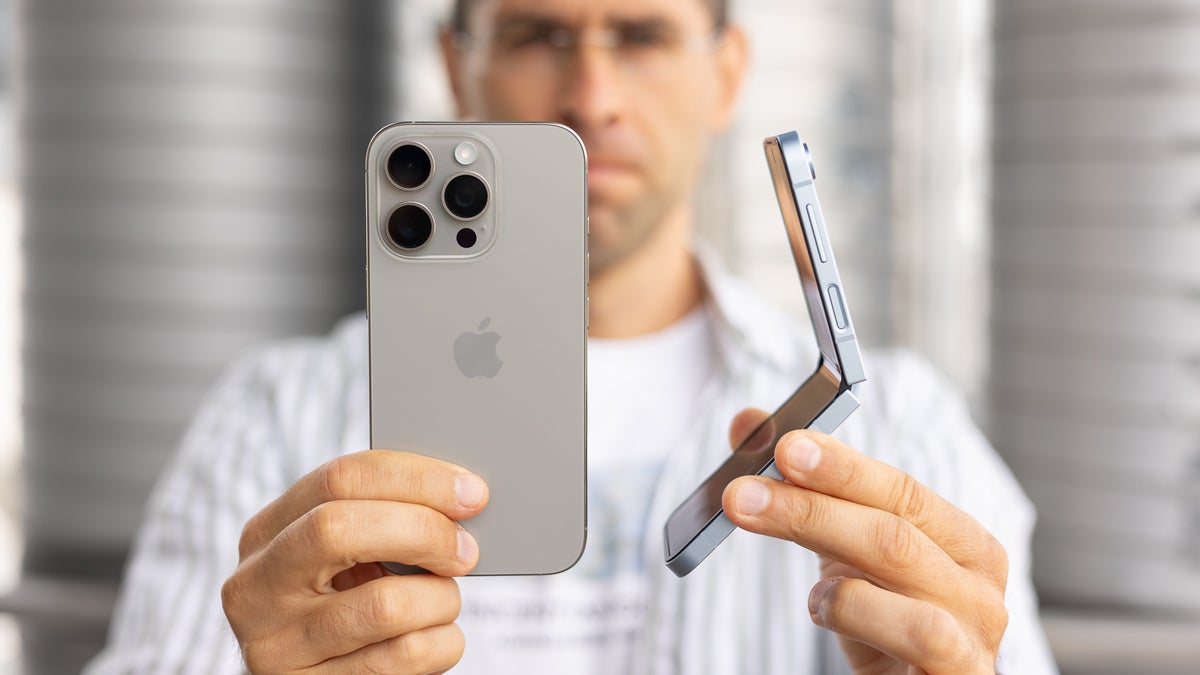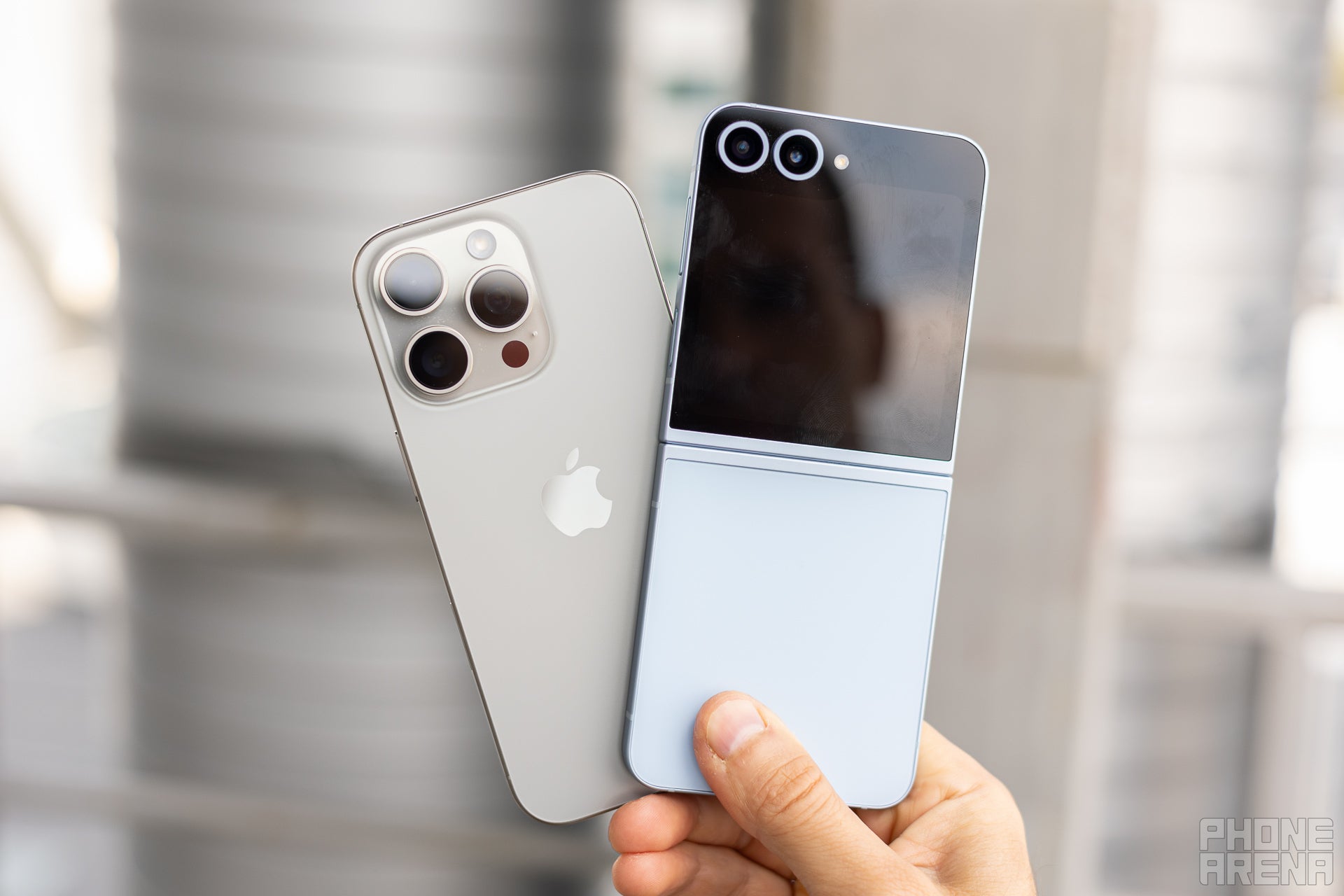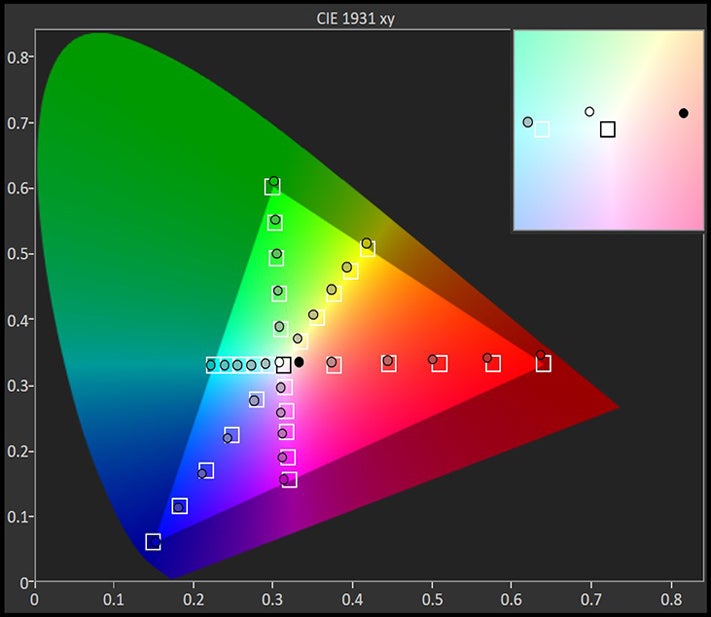Galaxy Z Flip 6 vs iPhone 16 Pro: We compare the incomparable
We may earn a commission if you make a purchase from the links on this page.

Intro
At first glance, the Galaxy Z Flip 6 and the iPhone 16 Pro are incompatible, just like the theories of General Relativity and Quantum Field Theory in physics. These two might seem incomparable, but there's something hidden, just like a hidden variable in the collapse of the wave function.
In the end, everything should lead us to a unified theory that should work in all cases and everywhere in the universe, and this applies to phones too. We're sure there are some people somewhere who will ponder whether to hop on the foldable train with a flip phone or play it safe and get the newly launched Apple Pro model.
So, today we will try to unify these two entities in a cohesive theory—we mean comparison. The iPhone 16 Series landed on September 9, 2024 so we have every ingredient to cook this sub-atomic comparison. Let's see how these two stack against each other in 2025!
Galaxy Z Flip 6 vs iPhone 16 Pro differences:
| Galaxy Z Flip 6 | iPhone 16 Pro |
|---|---|
| It folds in half! | Can't fold in half (more than once, at least) |
| It has two screens, one bigger, and one smaller | It has only one screen |
| It uses a Qualcomm processor | It's Apple silicon in there |
| Dual 50MP/12MP camera system | Triple camera system with a bonus telephoto lens |
| Aluminum frame | It has titanium in it |
| Bigger when unfolded, more compact when folded | Rock-solid dimensions, still pretty compact |
Design and Size
Apples and… exotic lychee fruits?

Surprisingly similar when the Galaxy is unfolded (Image by PhoneArena)
The world is holding its breath, waiting for the moment when Apple will finally announce a foldable phone, but until then, iPhones are bound to stay as they are now, rectangular slabs of glass and metal. The Apple “It’s Glowtime” event on September 9 didn't bring any significant changes to the iPhone Pro design, with some minor exceptions. There's a new Camera Control button onboard, which is really a Touch ID-inspired pressure sensitive sapphire crystal coated button. It also supports touch gestures but more on that in the Camera section.
Other than that, the iPhone 16 Pro looks and feels like its predecessor, it has a tad larger screen at 6.3 inches but thanks to the thinner bezels it has more or less the same dimensions as the previous model. There's a new hardened glass on top of that 1-nit minimum brightness screen, and it's next-gen Ceramic Shield glass that Apple says is two times more resistant than the one found in previous iPhones. There are some new hues available with the new iPhone 16 Pro model as well.
Appl iPhone 16 Pro available colors:
Appl iPhone 16 Pro available colors:
- Black titanium
- Natural titanium
- White titanium
- Desert titanium
The Galaxy Z Flip 6 follows in the footsteps of its predecessor, with minor tweaks and changes here and there. The dimensions are almost identical to its predecessor, but we have a redesigned hinge for better stability, and a slightly less prominent hinge.
There's a conceptual difference between these two, you can fold the Galaxy Z Flip in half and it becomes a different device. But you already knew this. In its unfolded state, the Z Flip 6 is somewhat close to the iPhone 16 Pro experience-wise.
As far as colors are concerned, the Galaxy Z Flip 6 is available in a wide range of hues
As far as colors are concerned, the Galaxy Z Flip 6 is available in a wide range of hues
Samsung Galaxy Z Flip 6 available colors:
- Blue
- Mint
- Silver Shadow
- Crafter Black (Samsung.com exclusive)
- Peach (Samsung.com exclusive)
- White (Samsung.com exclusive)
Display Differences

Flexible versus non-flexible (Image by PhoneArena)
The Galaxy Z Flip 6 features the same size for its main and cover screens as its predecessor, 6.7 inches and 3.9 inches, respectively. Those, of course, are AMOLED, and the main screen is capable of going up to 120Hz refresh rate and sports FHD+ resolution. The Z Flip 6 was able to output around 1,200 nits of brightness in our display test, and the minimum brightness figure was even more impressive at 0.7 nits. The color accuracy is not the best in the business, though, with an average deltaE of 2.76.
The iPhone 16 Pro comes equipped with a larger 6.3-inch display, with ProMotion 1-120Hz dynamic refresh rate, and the same resolution from its predecessor. Apple didn't mention anything regarding the screen brightness figures for the iPhone 16 Pro, but we suspect it's the same as last year. The last gen iPhone 15 Pro can shine with up to around 1,100 nits (real life brightness), so it's not far off the Z Flip 6. What's new is the 1-nit minimum brightness that Apple cited during the official event.
Display Measurements:
Even though the minimum brightness claims turned out to be true, the maximum brightness figures were not that impressive in our lab tests. There's a 150-nit advantage for the Galaxy Z Flip 6 in that department, but other than that, the other parameters are very similar, with a tad better color accuracy for the iPhone 16 Pro.
In terms of biometrics, the status quo remains unchanged; the iPhone 16 Pro relies on FaceID, while the Galaxy Z Flip 6 uses the same side-mounted capacitive fingerprint scanner as the previous Z Flip model.
Performance and Software
New Apple silicon
Due to the specific launch cycle these two models have, their beating hearts, the chipsets inside, are a generation apart. The Galaxy Z Flip 6 features the latest Snapdragon 8 Gen 3 chipset onboard, while the iPhone 16 Pro comes with the newest Apple silicon, the A18 Pro chip. We have the benchmark scores of the Z Flip 6, and they are quite impressive - 2251 and 7131 in single and multicore Geekbench 6 respectively.
This result is very close to the iPhone 15 Pro, but Apple said the new A18 Pro chip is 15% faster than A17 Pro, so the iPhone continues to be the smartphone to beat, when it comes to synthetic benchmarks. The thermal design has also been redesigned in the new model, giving it 20% improvement in heat management and better performance under sustained heavy loads. The graphics performance, however, is very close and in favor of the Galaxy Z Flip 6 during sustained load.
In terms of RAM, due to the different ecosystems and the way Android and iOS handle apps and optimize them prior to putting them on their respective stores, differences in RAM don't always translate into a difference in performance. The Galaxy Z Flip 6 has more RAM on paper, 12GB, while the iPhone 16 Pro features the same 8GB RAM capacity as its predecessor. Both of these phones support the newest and fastest Wi-Fi 7 standard, and to learn more about it, check out our dedicated article.
The software situation is an interesting one. We know that Samsung already has Galaxy AI to help people get onboard with the new reality, but Apple seems to be missing the party. On September 9 Apple announced a lot of new and interesting Apple Intelligence features, such as comprehensive writing tools, contextual search in photos and in videos, mail and notification summaries, something called "Visual Intelligence" (which looks very similar to Google Lens), as well as some Siri upgrades, but they will start to arrive in October and only in Beta shape and form.
Software updates used to be Apple's forte in the past, but ever since Google decided to offer seven long years of software support, things have changed. The Galaxy Z Flip 6 comes with seven years of major OS updates, while the iPhone 16 Pro offers "only" five.
Camera
Three is more than two, even in quantum physics

There's one additional camera on the iPhone 16 Pro, and it makes a difference (Image by PhoneArena)
The iPhone 16 Pro comes with a triple camera system and some cool upgrades to it as well. The main camera is the same as the one found on the iPhone 15 Pro, though. It's a 48MP, f/1.6 camera which Apple now calls Fusion Camera. The ultrawide camera has been upgraded, though. It now features a 48MP sensor with 0.7 microns pixel size or 1.4 microns when pixel binned under an f/2.4 lens, and you now have the ability to capture 48MP, 24MP and 12MP shots, and also macro shots.
The iPhone 16 Pro also moves to a tetraprism telephoto camera, taken from the Pro Max mode, and it offers 5x optical zoom, so there's no camera differences between this year's Pro and Pro Max models. This telephoto camera, consequently, is the biggest differentiator when it comes to comparing the phone to the Galaxy Z Flip 6.
The Galaxy Z Flip 6 features a dual camera system on the back, consisting of one upgraded 50MP main sensor, and one additional 12MP sensor for the ultrawide camera, and no dedicated telephoto onboard.
The other big advantage for the iPhone 16 Pro in this battle is the new Camera Control button. It's a capacitive, pressure sensitive button that can do a lot of things. A single click opens the camera app, you can light press it to bring up a menu, and you can swipe your finger to control settings such as zoom range, exposure and even apply post effects and styles.
Main Camera
Images from the main camera of both phones look surprisingly similar. The color tonality, white balance, exposure, level of detail, and dynamic range are all pretty close. The colors look more saturated on the Galaxy image but not by much, and there's the warmth iPhone devices are known for but again these two look very similar.
Another sample reveals some additional differences. Here the saturated colors in the Galaxy image are again obvious, and there's some sharpening going on as well. Still, in a blind comparison we're not sure one can pick up which is which.
Zoom Quality
Images above are captured at 5X zoom level, so there's a clear advantage for the iPhone 16 Pro. This year the model brings the same tetraprism telephoto camera as the one we know from the Pro Max model, and it comes with 5x native optical zoom. You can see the additional detail in the iPhone sample, it's clearer and crisper.
Ultra-wide
The ultrawide samples exaggerate the saturation that's going on in the Galaxy post processing. Colors look super bright and saturated, especially next to the much more natural color tonality of the iPhone 16 Pro. The bigger pixel count of the ultrawide camera also helps with detail (48MP versus 12MP on the Galaxy Flip 6). Overall, foldables from Samsung still lag a bit behind in the camera department compared to conventional, more rigid, flagships.
Front Camera
Front camera samples are very similar in quality, with the iPhone probably displaying better dynamic range and exposure. The samples from the Galaxy look just a tad brighter and flatter, but overall, very comparable.
Audio Quality and Haptics
Apple has redesigned the audio system inside its iPhone 16 Pro models, and we now have some very cool new features onboard. There are four studio-grade microphones able to capture high-quality recordings and thanks to Apple Intelligence do some interesting stuff, such as apply different Audio Mix styles, remove background noise, focus on the voice of the person in a video, and also overdub sounds over recordings in the Voice Memo app.
The Galaxy Z Flip 6, on the other hand, sports a stereo setup where the earpiece doubles as a secondary loudspeaker, and there are no upgrades to the audio quality or loudness, compared to the previous model. The same goes for the haptic motor. They are decent but nothing to write home about. There's no fancy-shmancy AI-driven audio magic at the moment, but it might come, as we live in the world of software updatable features.
The Galaxy Z Flip 6, on the other hand, sports a stereo setup where the earpiece doubles as a secondary loudspeaker, and there are no upgrades to the audio quality or loudness, compared to the previous model. The same goes for the haptic motor. They are decent but nothing to write home about. There's no fancy-shmancy AI-driven audio magic at the moment, but it might come, as we live in the world of software updatable features.
Neither of these two phones is expected to have a 3.5mm audio jack.
Battery Life and Charging
Upgrades

More capacity still equals more battery life (Image by PhoneArena)
There's a battery upgrade on the iPhone 16 Pro, and even though Apple didn't cite any numbers during the “It’s Glowtime” event, subsequent teardowns revealed that the battery is 3,582 mAh if we want to be exact. The Galaxy Z Flip 6, on the other hand, features a substantial upgrade compared to its predecessor; we now have a 4,000mAh battery inside Samsung's latest flip phone, and that's a 300mAh bump compared to the Z Flip 5.
This increase in capacity has indeed translated into longer battery life for the Z Flip 6, compared to its predecessor, and we're talking about hours. Now, one would expect the Galaxy to obliterate the iPhone due to the 500mAh difference but our battery test paints a different picture. These two are super close together, neck in neck. The iPhone holds its ground despite the smaller battery, probably thanks to the better optimization and the efficient chipset.
Battery Life Comparison:
Sadly, there was no word on faster wired charging during the Apple “It’s Glowtime” event, so the iPhone 16 Pro retains the same 26W wired charging speeds we know and lament from the previous model. The Galaxy Z Flip 6 also retains the 25W wired and 10W wireless charging speeds from the previous generation, and unsurprisingly the charging times are also very close between these two. It's worth noting that the wireless charging on the iPhone is much faster, so if that's your preferred way of charging your phone, the iPhone 16 Pro might be a better choice.
Specs Comparison
Here's a quick overview of the specs differences between the Galaxy Z Flip 6 and the iPhone 16 Pro. You can check out our detailed specs comparison on PhoneArena.
| Galaxy Z Flip 6 | iPhone 16 Pro | |
|---|---|---|
| Size, weight | Unfolded: 165.1 x 71.9 x 6.9 mm Folded: 85.1 x 71.9 x 14.9 mm 187 g | 149.6 x 71.45 x 8.25 mm, |
| Screen | 6.7" Super AMOLED 3.9" cover screen 120Hz | 6.3" OLED 120Hz ProMotion |
| Processor | Snapdragon 8 Gen 3 4nm | A18 Pro 3nm |
| RAM, Storage | 12/256GB 12/512GB LPDDR5x | 8/256GB 8/512GB LPDDR5x |
| Cameras | 50MP main 12MP ultra 10MP front | 48MP main 48MP ultra 12MP 5X zoom 12MP front |
| Battery | 4,000 mAh | 3,582 mAh |
| Charging | USB-C 25W wired 10W wireless | USB-C 27W wired MagSafe |
Summary

To flex or not to flex? (Image by PhoneArena)
It's very hard to tell whether one of these two is the better choice, all things considered. The only thing that makes these two comparable is the price, which is very close indeed. Samsung sells the new Galaxy Z Flip 6 for $1,099, and Apple offers the base 128GB iPhone 16 Pro model for $999.
The question is, do you want a flip phone for that kind of money, or do you want to play it safe and get an iPhone Pro. On the one hand, the iPhone 16 Pro has a better camera setup and a faster chipset but it's still a candy bar phone with no wow-factor attached to it (some might even call the design boring).
The question is, do you want a flip phone for that kind of money, or do you want to play it safe and get an iPhone Pro. On the one hand, the iPhone 16 Pro has a better camera setup and a faster chipset but it's still a candy bar phone with no wow-factor attached to it (some might even call the design boring).
To flip things once more, the Galaxy Z Flip 6 is a phone you can fold in half, and it has two screens, providing a completely different user experience, plus it will turn some heads. Until Apple launches its own foldable, Samsung (and other brands) will have an intrinsic advantage in offering more flexibility (pun intended) and a certain cool factor as well.
Follow us on Google News
































Things that are NOT allowed:
To help keep our community safe and free from spam, we apply temporary limits to newly created accounts: